Previous Page | Right click this page to print.
Macrominerals
In general, the macrominerals added as supplements to the rations of the various animal species are sodium, chlorine, calcium, phosphorus, magnesium, potassium, and sulfur. Table 8-1 on page 168-169 of the text lists sources of mineral supplements utilized in feed supplements, complete feeds, or in mineralized salt. The sources with an asterisk are sources most commonly utilized in commercial feeds.
Table 10.4 lists various mineral sources with intermediate and high relative
bioavailability.
Mineral |
Source |
Bioavailability |
|---|---|---|
| Calcium | Steamed bone meal Monocalcium phosphate Dicalcium phosphate Defluorinated phosphate Calcium carbonate Ground limestone Dolomite limestone |
High High High Intermediate Intermediate Intermediate Intermediate |
| Phosphorus | Calcium phosphate Phosphoric acid Sodium phosphate Steamed bone meal Defluorinated phosphate Dicalcium phosphate |
High High High High Intermediate Intermediate |
| Magnesium | Magnesium carbonate Magnesium chloride Magnesium oxide Potassium and magnesium sulfate |
High High High High |
| Potassium | Potassium chloride Potassium sulfate Potassium and magnesium sulfate |
High High High |
| Sulfur | Potassium sulfate Potassium and magnesium sulfate Sodium sulfate |
High High Intermediate |
| Cobalt | Cobalt carbonate Copper sulfate |
High High |
| Copper | Copper sulfate Copper chloride Copper carbonate Copper nitrate |
High High Intermediate Intermediate |
| Iodine | Potassium iodide, stabilized | High |
| Iron | Ferrous sulfate | High |
| Manganese | Manganese sulfate Manganese carbonate |
High High |
| Selenium | Sodium selenate Sodium selenite |
High High |
| Zinc | Zinc carbonate Zinc sulfate Zinc chloride |
High High Intermediate |
In addition to this table, the macrominerals sodium and chlorine are also
commonly supplemented.
The most common mineral supplement added to rations is sodium chloride,
also known as salt.
Figure 10.1 illustrates salt.
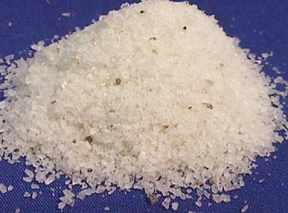
Salt provides sodium and chlorine; dietary required macrominerals. Salt
is almost pure sodium chloride. Salt may be fed alone or fed with additional
components, both nutritive and nonnutritive components. Salt may function
as a carrier when fed with additional components. Iodized salt is sodium
chloride with an iodine-containing compound added. Trace-mineralized salt
is salt with microminerals added. Common microminerals added in the trace-mineralized
mixture are cobalt, copper, iron, iodine, manganese, and zinc. In addition,
sulfur and magnesium and a limited amount of selenium may be added.
Figure 10.2 illustrates trace-mineralized salt.
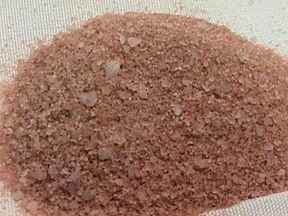
Trace-mineralized salts are appropriate in a number of production situations.
As trace-mineralized salt may pose an issue is specific regions, it is
important to analyze each specific production situation. In addition to
microminerals, nonnutritive additives such as antibiotics and anti-bloating
compounds may be added to salt. For ruminants and horses, supplemental
salt may be added to the ration or fed ad-libitum separate from the ration.
Salt added to the ration should be fine in texture and free-flowing. Offered
ad-libitum, salt may be provided loose or as a compressed block; form
of feeding is influenced by factors such as cost per unit, climate, and
competition for supplement. Figure 8.4 on page 170 of the text illustrates
an example of a feeder that provides loose salt protection from the elements.
Figure 8-3 on page 170 of the text illustrates cattle consuming salt from
a compressed block. For poultry and swine, in general, supplemental salt
will be added to the ration.
In general, sodium chloride is added to the majority of animal rations.
The requirements for sodium and chlorine will increase as fluid losses
of an animal increase. Two common forms of fluid loss are sweat and milk.
The requirements will also increase for ruminants and horses consuming
forages high in potassium content. For ruminants and horses, in general,
0.5-1.0% is added to commercial formulas. In addition, various supplemental
concentrates may contain 1.0-3.0% salt. For poultry and swine, in general,
feedstuffs contain 0.25-0.5% salt. Excess salt is a potential issue for
all species. Poultry and swine are more susceptible to toxicity compared
to other animals. To prevent toxicity, the producer should have knowledge
of the relative salt contents in feedstuffs and water and provide adequate
water. Salt is an attractive and palatable feedstuff to animals. Animals
may be expected to consume enough salt to at least meet their requirement
for sodium and chlorine.
In general, supplementation of calcium and phosphorus to animal rations
is required. Regarding the various types of feedstuffs in rations, forages
are relatively low in P and high in Ca and grains and similar concentrates
are relatively low in Ca and high in P. In general, the bioavailability
is similar across calcium sources. In contrast, the bioavailability of
phosphorus varies significantly between phosphorus sources.
In plant-based sources of phosphorus approximately half of the phosphorus
is bound with phytic acid in a phytate complex. For monogastrics, phytin
P is relatively unavailable. Therefore, for plant-based sources of phosphorus
fed to monogastrics, consider approximately half of the phosphorus available
for absorption. In contrast to monogastrics, microorganisms in the rumen
synthesize phytase which releases phytin P, making it available for absorption
by the ruminant. Therefore, for plant-based sources of phosphorus fed
to ruminants, consider a greater amount of the phosphorus available for
absorption. The bioavailability of inorganic sources of phosphorus also
varies. Well utilized sources include phosphoric acid and mono, di, and
tricalcium phosphates.
Dicalcium phosphate is a common source of calcium and phosphorus.
Figure 10.3 illustrates dicalcium phosphate.
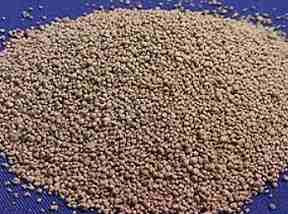
The average composition of calcium and phosphorus is 25-28% and 18-21%,
respectively. In addition to a favorable bioavailability, dicalcium phosphate
is also low in fluorine.
Additional bone-based products include steamed bone meal, bone charcoal,
spent bone charcoal, and bone ash.
Figure 10.4 illustrates steamed bone meal.

The contents of calcium and phosphorus in the various bone-based products
vary. In general, the bone-based products are favorable sources of calcium
and phosphorus.
Monocalcium phosphate contains approximately 20% calcium and 21% phosphorus.
Tricalcium phosphate contains approximately 38% calcium and 18% phosphorus.
Each of these is a favorable source.
Defluorinated phosphate is another source of phosphorus.
Figure 10.5 illustrates defluorinated rock phosphate.
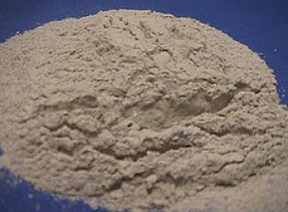
The average phosphorus content is 14% and the bioavailability is favorable.
The average phosphorus content of phosphoric acid is 23-25%. The bioavailability
of phosphoric acid is high. Phosphoric acid is often added to liquid supplements
for ruminants.
Ammonium phosphate is produced by treating phosphoric acid with ammonium.
Ammonium phosphate is available as monoammonium and diammonium. In addition
to a source of phosphorus, ammonium phosphate is a source of nitrogen
for ruminant species. The minimum nitrogen content for monoammonium and
diammonium phosphate is 9 and 17%, respectively. As a source of nitrogen
for ruminants, the maximum inclusion rate is at the point the product
provides 2% of the total crude protein of the ration. The phosphorus content
for monoammonium and diammonium is 25% and 20%, respectively.
Additional sources of phosphorus are mono and disodium phosphate. Availability
of these sources is also favorable.
Additional sources of calcium are various sources of calcium carbonate
and calcium sulfate. Sources of calcium carbonate include limestone and
oyster shells.
Figure 10.6 illustrates ground limestone.
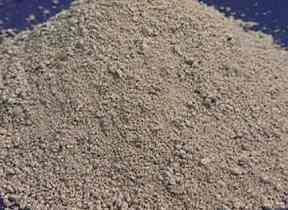
Calcium sulfate provides a source of sulfur. Sulfur is essential for microbial
protein synthesis of sulfur-containing amino acids. Dolomite limestone
also contains at least 10% magnesium. Although the minimum magnesium content
for dolomite limestone is 10%, the bioavailability is low for some species.
In general, these are favorable sources of calcium.
In general, the supplementation of magnesium to animal rations is required.
The preferred source of magnesium is magnesium oxide. The average magnesium
content is 54-60% and the bioavailability is favorable. Additional sources
are magnesium carbonate and magnesium sulfate; the respective magnesium
contents are 21-28% and 10-17%. The bioavailability of each source is
also favorable.
Potassium is generally required for ruminants on high-concentrate rations
and in the rations of monogastrics. Sources of potassium include potassium
chloride, sulfate, and carbonate. The content and bioavailability of the
sources is favorable.
Supplemental sulfur is generally required for ruminants, especially ruminants
consuming NPN compounds. Favorable sources of sulfur include potassium
sulfate and magnesium sulfate. Elemental sulfur may also be added to rations.
To fulfill the sulfur requirements of monogastrics, monogastrics should
be fed sulfur-containing proteins.
Previous Page | Right click this page to print.